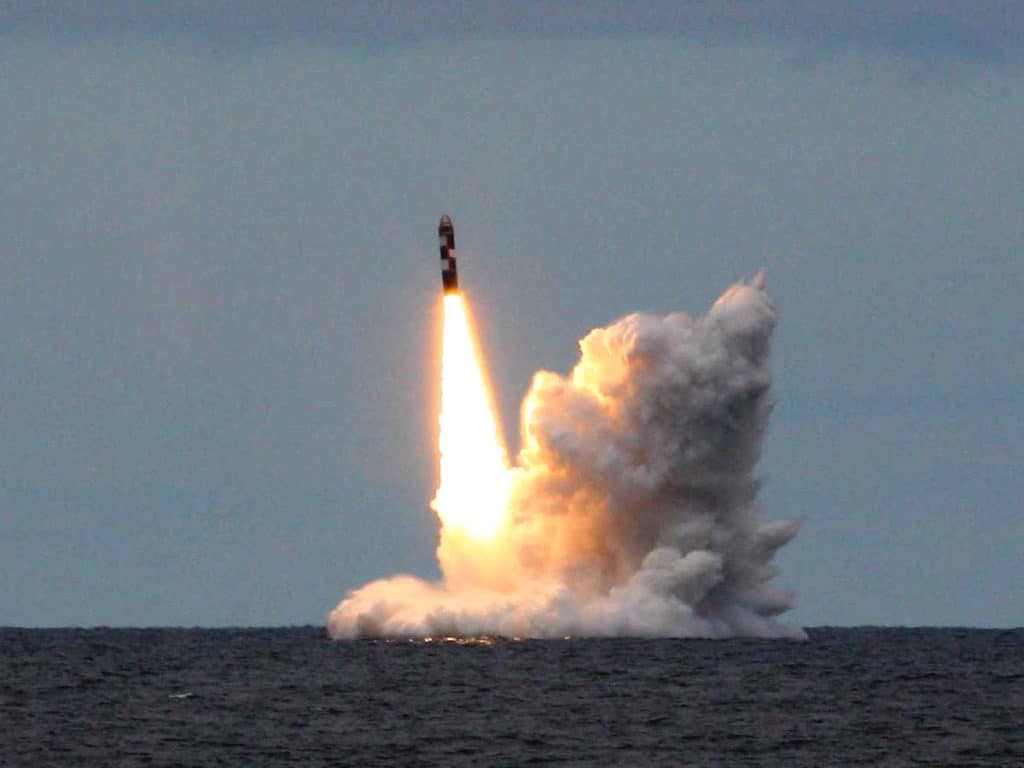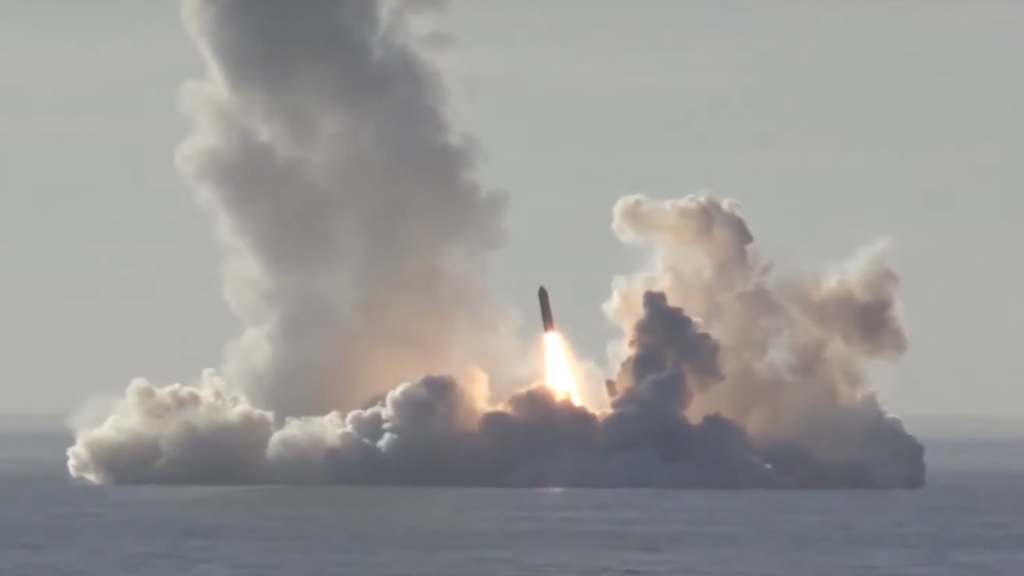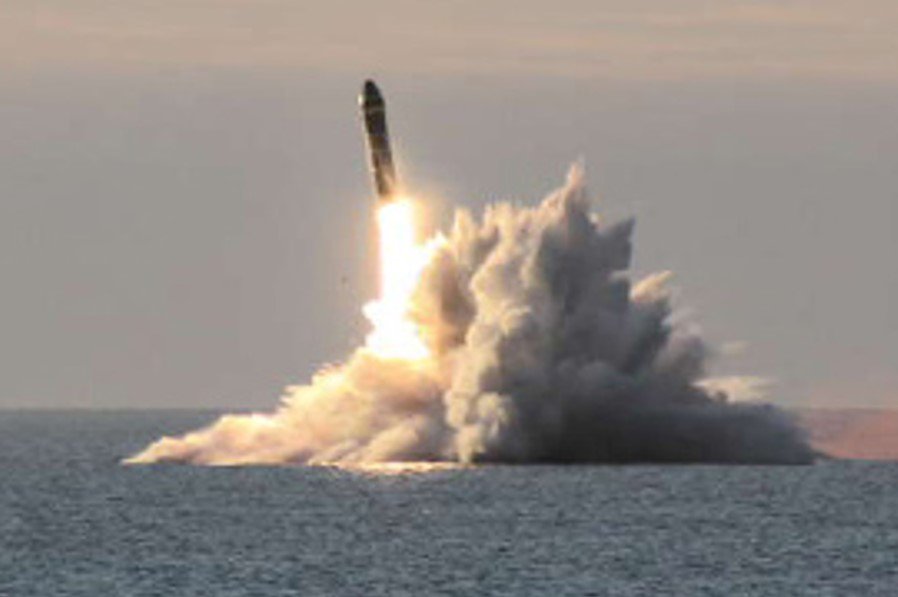The RSM-56 Bulava (NATO: SS-N-32) is an intercontinental-range, submarine-launched, solid propellant ballistic missile. Alongside the SS-25 and the SS-27, both land-based ICBMs, the Bulava represents a core component of Russia’s future strategic nuclear force. Development of the program began in the 1990’s with official production contacts going into effect in the 2007-2008 timeframe. The Bulava was designed to be deployed onto Russia’s Borey-class ballistic missile submarines (SSBN’s), also referred to as Dolgorukiy-class or Project 955 submarines, which are capable of holding 12-16 missiles each.1
Bulava (SS-N-32) at a Glance
- Originated from
- Russia
- Possessed by
- Russia
- Alternate names
- Bulava, RSM-56, SS-N-32
- Class
- Submarine-launched Ballistic Missile (SLBM)
- Basing
- Submarine-launched
- Length
- 12.1 m
- Diameter
- 2.0 m
- Launch weight
- 36,800 kg
- Payload
- Up to 10 MIRVs, 1,150 kg
- Warhead
- Nuclear 100 – 150 kT
- Propulsion
- Three-stage solid propellant
- Range
- 8,300 km
- Status
- Operational
- In service
- 2013

Bulava test launch. Photo: Russia MoD 
Bulava 4-missile salvo test, 2018. Photo: Russia MoD 
Bulava salvo launch test, 2016. Photo: Russia MoD
Bulava Development
The first Borey SSBN was commissioned in January 2013 and is stationed with Russia’s Northern Fleet. The second Borey-class sub was commissioned in April 2015, and as of September 2015 is stationed with the nation’s Pacific Fleet. A third has been commissioned but has yet to be deployed for specific assignment.2 Reports indicate that Russia plans to field 6-8 Borey-class submarines.3
The first powered flight test of the Bulava missile occurred in September 2005. It’s first submerged test launch followed in December. It demonstrated its ability to be launched from its host, a Borey SSBN, in June 2011. As of November 2015, the missile has undergone 24 total tests, 16 of which are considered successes.4
Specifications
The dimensions of the Bulava missile is not precisely known, but it is estimated that it is 12-13.5 m in length, has a diameter of approximately 2.0 m, and weighs between 36,000-39,000 kg.5 The missile is expected to carry 10 MIRV warheads, with a yield of 100-160 kT, to a maximum distance of 8,300 km. The missile would likely carry decoys and according to Russian officials, the missile’s RV’s are capable of in-flight maneuverability and re-targeting to out maneuver any enemy defense.6 The RVs have an expected accuracy around 250 to 300 m CEP.7
Footnotes
- “Bulava (RSM-56),” in IHS Jane’s Weapons: Strategic 2015-2016, ed. James C. O’Halloran (United Kingdom: IHS, 2015), 79.
- Franz-Stefan Gady “Russia Deadliest Sub is Heading to the Pacific,” The Diplomat, September 2015, http://thediplomat.com/2015/09/russias-deadliest-sub-is-heading-to-the-pacific/
- “Bulava (RSM-56),” in IHS Jane’s Weapons: Strategic 2015-2016, ed. James C. O’Halloran (United Kingdom: IHS, 2015), 79.
- “Bulava (RSM-56),” in IHS Jane’s Weapons: Strategic 2015-2016, ed. James C. O’Halloran (United Kingdom: IHS, 2015), 79; Franz-Stefan Gady, “Confirmed: ‘Russia’s Deadliest Sub’ Test Fires 2 Ballistic Missiles,” The Diplomat, November 18, 2015.
- “Bulava (RSM-56),” in IHS Jane’s Weapons: Strategic 2015-2016, ed. James C. O’Halloran (United Kingdom: IHS, 2015), 79.
- “Defense Minister Presents New Strategic Missile,” RFE/ RL Report, September 29, 2005.
- “Bulava (RSM-56),” in IHS Jane’s Weapons: Strategic 2015-2016, ed. James C. O’Halloran (United Kingdom: IHS, 2015), 79.